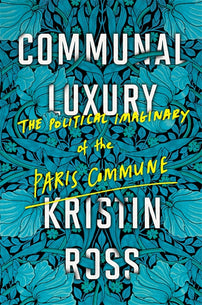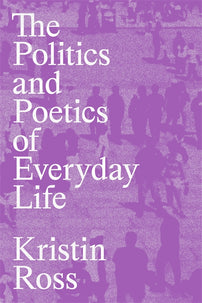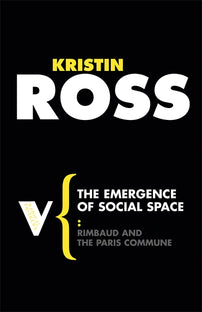The detective as social geographer
How the private eye became key in historicizing France’s recent past in the seventies and eighties.

Writing in 1993, at the height of the “spatial turn” in cultural analysis, Rosalyn Deutsche drew our attention to the way in which the figure of the urban theorist—her examples are Edward Soja and Mike Davis—had merged with that of the private eye in noir fiction and film. Given that the city is both scene and object of noir investigation, she commented, the analogy between the detective’s disinterested search for the hidden truth of the city and the urban scholar’s critique of the capitalist city practically suggests itself.
Deutsche does not go so far as to explicitly base her case on the centrality of one city—Los Angeles—to both the urban theory then being produced by Soja and Davis and a noir tradition that includes Raymond Chandler and Chinatown. Yet, if the analogy works so seamlessly, it clearly has something to do with the way it springs unbidden from the set of representations, both written and figured, that make up an imaginary particular to Los Angeles. And it is also because an earlier subterranean migration between the two figures—a transfer of practices and point of view—had already laid the groundwork for an understanding of the detective himself as a kind of geographer, engaged in the mapping of social space.
The detective as social geographer emerged in early essays by Fredric Jameson, writing about Chandler. The spatial paradigm provided by the meeting of Jameson, Chandler, and the urban particularities of Los Angeles has largely overdetermined the way in which we read detective fiction. Yet, in France, where the detective genre has emerged as one of the privileged venues for social and political critique, the narrative mechanisms and the figure of the detective have been substantially altered and put in the service of a new critical project: that of historicizing the recent past.
In their reworking of aspects of the noir paradigm to provide an alternative perspective onto postwar Europe, crime-fiction writers in France, publishing in the wake of the political upheavals of 1968, demand to be read as a new kind of historiography. Their analysis of the effects of events in the recent past, offered up in widely distributed and widely read “pulp” stories, parallels and, to a certain extent, surpasses developments within the fields of critical theory and contemporary historiography.
Of all the various kinds of literary characters, the detective is one of the easiest to think of as little more than narrative scaffolding, a string or device whose wanderings link the various anecdotes, local histories, and glimpses of local color into a narrative whole. After all, what other fictional character’s underdeveloped personality or lack of “roundedness” is so regularly compensated for by an all-consuming fetish—the love of orchids, for example, or the love of opera? Jameson saw the problem confronting Chandler to be the peculiarly American mid-twentieth century dilemma of how to motivate the plausible narrative intersection of people from extremely different walks of life: different classes and races, all the fragmented social sectors, all the compartmentalized private dramas that make up Los Angeles’s urban sprawl.
For it was Los Angeles, the center-less, horizontal city, that in Chandler’s novels would become a futuristic forecast of the country as a whole. The detective is the character whose professional obligations and routine wandering oblige him to travel between isolated parts of the city, those otherwise hermetically sealed social spaces: in the case of Philip Marlowe, between shabby rooming houses and elegant private clubs set back off the street on long driveways lined with manzanita trees; between seedy hotel lobbies and offshore gambling ships; between the desert dry-out spas for socialites and debutantes and the dingiest of office interiors.
For Jameson, the proof that the very content of Chandler’s novels is a scenic one lies in the way we remember certain “types” or characters in his novels on the basis of the residences, the houses, doorframes, or interiors with which these types are associated, rather than on the basis of their own characterological merit or personal history. It is this essentially scenic content that conjures up and demands the invention of a figure who can, almost magically, unite the diverse parts of the city and, in grasping that spatial totality, create a topography of the social whole.
Jameson makes a strong case for the Americanness of this new invention: the detective as social geographer whose solution to the mystery derives from his ability to grasp a spatial totality. In France, when a number of far-left political activists in the 1970s and 1980s turned to writing detective novels (polars), they effectively steered the genre toward the depiction of a society whose current anxieties and troubles are the result of unexpiated historical crime.
French polar writers like Jean-François Vilar and Didier Daeninckx retain the almost invariably urban setting of their North American precursors. But, in the move from 1930s Los Angeles to postwar Paris, the figure of the detective—as vehicle for knowledge, as narrative scaffolding, as instrument of perception, as consciousness—could not be transported unaltered: he must be essentially reinvented.
Noir fiction had become a significant part of the contemporary struggle over the popular memory of the recent past, and particularly the popular memory of the political upheavals of the 1960s. Taken as a group, and quite unsystematically, the novels offer a new form of history and memory of the recent past that is neither commemorative nor nostalgic, and that frequently blurs the line between history and memory.
In novels by Daeninckx, Vilar, Frédéric Fajardie, Gérard Delteil, Jean-Bernard Pouy, Jean-Claude Izzo, and Thierry Jonquet, among others, the causes of contemporary crime are to be found in the history of bourgeois society, and, within that history, in the events of the recent past: the Spanish Civil War, the consequences of World War II and the extermination of European Jews, May ’68, but above all the Algerian War and the persistence of colonial crime and its unfinished politics.
The emphasis on colonial crime by writers of the 1970s and 1980s derives in part from the authors’ own political experience: their childhood and adolescence coincided, for the most part, with the troubles in Paris and elsewhere as the Algerian War drew to an end.
But their insistence, more generally, on an event-driven history of the recent past, particularly at a moment when professional historians favored the glacial narrative rhythms of the longue durée, has led many critics, practitioners, and readers alike to claim for the polar of these years the status of the novelistic form best suited to the twentieth century, and the one that offers the most accurate version of postwar history.
In an introduction to fellow Trotskyist Ernest Mandel’s little book on the roman noir, Vilar summed up what he took to be the fortuitous match between noir sensibility and the era which, in Europe at least, its adherents set themselves the task of chronicling: “The century of wars and revolutions, and thus of utopias a hairsbreadth away, is necessarily the century of trials and betrayals.” The plot, intrigue, and attitude of noir, it seemed, could be used to narrate key moments in a totality conceived of first and foremost not as spatial, but as historical.
— excerpted from The Politics and Poetics of Everyday Life by Kristin Ross
[book-strip index="1"]


